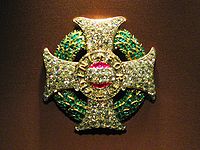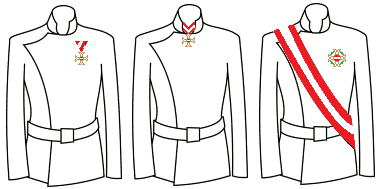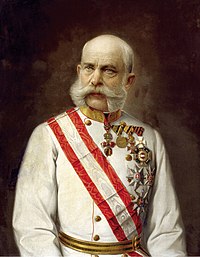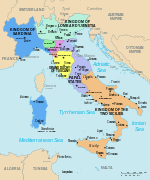This is an old revision of this page, as edited by JMvanDijk (talk | contribs) at 17:10, 6 November 2015 (→Knight’s Cross). The present address (URL) is a permanent link to this revision, which may differ significantly from the current revision.
Revision as of 17:10, 6 November 2015 by JMvanDijk (talk | contribs) (→Knight’s Cross)(diff) ← Previous revision | Latest revision (diff) | Newer revision → (diff)| This article needs additional citations for verification. Please help improve this article by adding citations to reliable sources. Unsourced material may be challenged and removed. Find sources: "Military Order of Maria Theresa" – news · newspapers · books · scholar · JSTOR (January 2011) (Learn how and when to remove this message) |



The Military Order of Maria Theresa (Militär-Maria-Theresien-Orden in German, Katonai Mária Terézia-rend in Hungarian, Vojenský řád Marie Terezie in Czech, Wojskowy Order Marii Teresy in Polish, Vojaški red Marije Terezije in Slovenian, Croatian: Vojni Red Marije Terezije) was an Order (decoration) of the Austro-Hungarian Empire founded on June 18, 1757, the day of the Battle of Kolin, by the Empress Maria Theresa to reward especially meritorious and valorous acts by commissioned officers, including and especially the courageous act of defeating an enemy, and thus, "serving" their monarch. It was specifically given for "successful military acts of essential impact to a campaign that were undertaken on own initiative, and might have been omitted by an honorable officer without reproach." This gave rise to a popular myth that it was awarded for (successfully) acting against an explicit order. It is considered to be the highest honor for a soldier in the Austrian armed services.
Originally, the order had two classes: the Knight's Cross and the Grand Cross. On October 15, 1765, Emperor Joseph II added a Commander's Cross and a breast star to be worn by holders of the Grand Cross.
A prospective awardee was considered only in regards to their military service record; their ethnicity, birth and rank (as long as he was a commissioned officer) were irrelevant. Knight Cross recipients were automatically ennobled with the title of Ritter in the Austrian nobility for life, and admitted to court. Upon further petition they could also claim the hereditary title of Baron (Freiherr). They were also entitled to a pension. Widows of the order's recipients were entitled to half of their spouse's pension during the remainder of their lives.
The order ceased to be awarded by the Austrian emperor on the fall of the Habsburg Dynasty in 1918, when its last sovereign, Charles I, transferred his powers concerning this honour to the Order Chapter. The Chapter then processed applications until its last meeting in 1931, when it was decided that further awards should not be made. Membership of the order has been awarded a total of 1241 times.
On the 4th of November 1938, it was decided in Hungary to award further decorations of the order, citing legal continuity as long as Hungary's royal power is exercised by the Regent Miklós Horthy, the Regent shall perform the duties of the Order's Grand Master in Hungary. He was decorated with the orders knight's cross.
During World War II only one person received the Knights's Cross of the Order of Maria Theresia. Major general Kornél Oszlányi commanding officer of the Royal Hungarian Army's 9th Light Infantry Division for the battles at the river Don near Voronezh.
The last surviving knight of the Order was k.u.k. Fregattenleutnant Gottfried Freiherr von Banfield. He received the honour in 1917 for his services as a maritime aviator during World War I and headed the Tripcovich Shipping Company in Trieste after the war. He died in 1986, aged ninety-six.
Insignia
- The badge of the order was a gilt, white-enameled cross. The central disc is also in enamel, bearing the coat-of-arms/national flag of Austria, surrounded by a white ring bearing the motto "Fortitvdini" (Fortitude).
- The star of the order was a silver faceted cross of the same shape as the badge, with a wreath of green-enameled oak leaves between the arms of the cross. The central disc is the same as the one on the badge.
- The ribbon of the order was red-white-red, from the national flag of Austria.
 | ||
| Ribbon bars | ||
|---|---|---|
Recipients of the Order (examples)

Grand Cross
- Field Marshal H.M. Franz Joseph I, emperor and king of Austria-Hungary.
- Count Eduard Clam-Gallas (14 March 1805, Prague – 17 March 1891, Vienna) was an Austrian General.
- Count Leopold Joseph von Daun (or Dhaun) (September 24, 1705 – February 5, 1766), later Prince of Thiano, Austrian field marshal, was born at Vienna, as son of Count Wirich Philipp von Daun.
- András Hadik de Futak (German: Andreas Reichsgraf Hadik von Futak; Hungarian: futaki Hadik András gróf; Slovak: Andrej Hadík; October 16, 1710 – March 12, 1790) was a Hungarian Count. He was commander of a Habsburg army corps in the Seven Years' War under Prince Charles Alexander of Lorraine.
- Paul von Hindenburg (2 October 1847 – 2 August 1934) was a German field marshal, statesman, and politician, and served as the second President of Germany from 1925 to 1934.
- Anton Ludwig August von Mackensen (6 December 1849 – 8 November 1945), born August Mackensen, was a German soldier and field marshal. He commanded with success during the First World War and became one of the German Empire's most prominent military leaders.
- Archduke John of Austria (German: Johann von Österreich; 20 January 1782 – 11 May 1859) was a member of the Habsburg dynasty, an Austrian field marshal and German Imperial regent (Reichsverweser).
- Johann Josef (Joseph) Wenzel (Anton Franz Karl) Graf Radetzky von Radetz (English: John Joseph Wenceslaus, Count Radetzky of Radetz, Czech: Jan Josef Václav hrabe Radecký z Radce) (Schloss Trebnitz (Czech: Trebnice), Bohemia, November 2, 1766 – Milan, Italy, January 5, 1858) was a Czech nobleman and Austrian general, immortalised by Johann Strauss I's Radetzky March. General Radetzky was in the military for over 70 years, until his death at age 91, and is known for the victories at the Battles of Custoza (July 24–25, 1848) and Novara (March 23, 1849) during the First Italian War of Independence.
- Wilhelm II, German Emperor (German: Friedrich Wilhelm Viktor Albrecht; English: Frederick William Victor Albert) (27 January 1859 – 4 June 1941) was the last German emperor and king of Prussia.
Commander's Cross
- Feldmarschalleutnant Emanuel Cvjetićanin (b. 8 August 1833). In the war of 1878–1882, Cvjetićanin was the main organizer of the gendarmerie in Sarajevo. He received numerous decorations, including the Order of Maria Theresa, and the title of baron. He was the first adjutant of Emperor Franz Josef I.
- Count Eduard Clam-Gallas (14 March 1805, Prague – 17 March 1891, Vienna) was an Austrian General.
- Svetozar Boroević (or Borojević) von Bojna (December 13, 1856 – May 23, 1920) was a Croatian - born Austro-Hungarian Field Marshal.
- Eduard von Böhm-Ermolli (February 12, 1856 – December 9, 1941) was an Austrian general during World War I.
- Friedrich Wilhelm Freiherr von Bülow, Graf von Dennewitz (February 16, 1755 – February 25, 1816) was a Prussian general of the Napoleonic Wars.
- Count Viktor Dankl von Krasnik (German: Viktor Graf Dankl von Krasnik, born as Viktor Dankl on September 18, 1854, in Udine, died January 8, 1941 in Innsbruck) was a highly decorated career Austro-Hungarian officer who reached the pinnacle of his service during World War I with promotion to the rare rank of Colonel General (Generaloberst).
- Anton Haus (June 13, 1851 - February 8, 1917) was an Austrian naval officer.
- Julius Jacob von Haynau (October 14, 1786, Kassel – March 14, 1853) was an Austrian general.
- Heinrich Hermann Josef Freiherr von Heß (1788, Vienna - 1870, Vienna), Austrian soldier, entered the army in 1805.
- Count Josip Jelačić von Bužim (16 October 1801, Peterwaradein – 20 May 1859, Zagreb); also spelled Jellachich, Jellacic or Jellasics) was the Ban of Croatia between 23 March 1848 and 19 May 1859.
- Archduke Joseph August Viktor Klemens Maria of Austria, Prince of Hungary and Bohemia (9 August 1872 – 6 July 1962) was for a short period head of state of Hungary, a member of the House of Habsburg-Lorraine and the eldest son of Archduke Joseph Karl of Austria (1833–1905)
- Hermann Kövess von Kövessháza (March 30, 1854 – September 22, 1924) was the final, and completely ceremonial, Commander-in-Chief of Austria-Hungary. He served as a generally competent and unremarkable commander in the Austro-Hungarian Army and was close to retirement in 1914 when The First World War broke out and he was given a command post.
- Laval Graf Nugent von Westmeath (Ballynacor, Ireland, November 3, 1777 - Karlovac, Croatia, August 21, 1862) was a soldier of Irish birth who fought in the armies of Austria and the Two Sicilies.
- Arthur Freiherr Arz von Straussenburg (or Straußenburg) June 16, 1857 - June 1, 1935, was an Austro-Hungarian Colonel-General and last Chief of General Staff to the Austro-Hungarian Army.
- Henry Paget, 1st Marquess of Anglesey (May 17, 1768 – April 29, 1854), also known as Lord Uxbridge. Commanded the Cavalry Corps of the Anglo-Allied Army at the Battle of Waterloo on June 18, 1815.
- Rowland Hill, 1st Viscount Hill (August 11, 1772 – December 10, 1842), Lord Hill commanded the II Corps of the Anglo-Allied Army at Waterloo.
Knight’s Cross
- Feldmarschalleutnant Emanuel Cvjetićanin8.8.1833.In the war of 1878–1882, Cvjetićanin was the main organizer of the gendarmerie in Sarajevo. He received numerous decorations, including the Order of Maria Theresa, and the title of baron. He was the first adjutant of Emperor Franz Josef I.
- Count Eduard Clam-Gallas (14 March 1805(1805-03-14) in Prague – 17 March 1891 in Vienna) was an Austrian General.
- Major-General Sir Robert Henry Dick, KCB, KCH - 73rd Foot - died of wounds, 10 February 1846.
- Karl Mack von Leiberich, Freiherr (25 August 1752 – 22 December 1828) was an Austrian soldier. He is best remembered as the commander of the Austrian forces defeated and captured by Napoleon's Grande Armée in the Battle of Ulm in 1805.
- Tadeusz Jordan-Rozwadowski, known in Austria as Thaddäus Ritter (later Count, after his father's death) Jordan-Rozwadowski von Groß-Rozwadów,(19 May 1866 – 18 October 1928) was a Polish military commander, diplomat, and politician, a general of the Austro-Hungarian Army and then the Polish Army. He was a Feldmarschall-Leutnant and became the commanding officer of the 43rd Infantry Division, which he led during the victorious battle of Gorlice..
- Korvettenkapitän Georg Ludwig von Trapp. Father of the famous Von Trapp family that inspired the movie The Sound of Music. He was awarded the order for becoming "the dread of the Adriatic" for sinking 13 ships as a submarine commander during the First World War. Born April 4, 1880, he died of lung cancer in Vermont on May 30 1947. He received lung cancer from the toxic fumes emitted from his submarine during the war. Out of all the medals he was awarded, this one was his favorite, and the only one he was able to smuggle out of Austria.
- Viktor Weber Edler von Webenau (* 13 November 1861 in Neuhaus; † 6 May 1932 in Innsbruck), General in the Austro-Hungarian army while World War I, military governor of Montenegro between 1916 and 1917 and head of the Austro-Hungarian armistice commission (Armistice of villa Giusti)
- Alois Windisch (awarded 11 December 1925) (3 February 1892 – 28 December 1958) was a highly decorated Generalmajor in the Wehrmacht during World War II. He was also a recipient of the Knight's Cross of the Iron Cross. The Knight's Cross of the Iron Cross was awarded to recognise extreme battlefield bravery or successful military leadership. Alois Windisch was captured by Soviet troops in 1945 and was extradited to Yugoslavia. He was sentenced to 20 years imprisonment, but was released in 1953.
- Ferdinand, Freiherr of Wintzingerode (15 February 1770, Allendorf - 16 June 1818, Wiesbaden) was a German nobleman and officer in several different armies of the Napoleonic Wars, finally ending up as a general in the Imperial Russian army and fighting in the War of the Sixth Coalition against the French invasion of Russia and the subsequent campaigns in Germany and France. He appears in Tolstoy's War and Peace.
- Eugen Count Wratislaw von Mittrowitz-Nettolitzky (* 8. July, 1786, in Wischopol (Czech: Dolní Bousov), Bohemia; † 14. February, 1867, in Vienna) was an Austrian Fieldmarshal.
- Maximilian Daublebsky Freiherr von Sterneck zu Ehrenstein (14 February 1829, Klagenfurt - 5 December 1897, Vienna) was an Austrian admiral who served as the chief administrator of the Austro-Hungarian Navy from 1883 until his death.
- Feldmarschalleutnant Nikolaus Esterhazy, prince Eszterhazy of Galantha (18. dec. 1714 - 28 sept. 1790). Universally recognized for his patronage of the Austrian Composer Joseph Haydn. He received the Order upon his bravery in the Battle of Kolin
- Andreas Graf O'Reilly von Ballinlough (3 August 1742 – 5 July 1832) was an Austrian soldier and military commander of Irish origin. His military service extended through the Seven Years' War, War of the Bavarian Succession, Austro-Turkish War, French Revolutionary Wars, and Napoleonic Wars. He retired from the army in 1810 and died at age 89.
- Johann Iskrić (3 March 1884 – 14 June 1961) who received the Knight's cross for his conduct and bravery in the Eleventh Battle of the Isonzo in the World War I.
- Miklós Horthy (18 June 1868 - 9 February 1957) was a Hungarian naval officer, commanding officer of the SMS Novara received the Knight's Cross on March 7. 1921. for the Battle of the Strait of Otranto.
See also
![]() Media related to Military Order of Maria Theresa at Wikimedia Commons
Media related to Military Order of Maria Theresa at Wikimedia Commons
References
- Hrvatska u Prvome svjetskom ratu, Vjesnik
- http://rendjel.myhunet.com/hu/A-kiegyezestol-az-I.-vilaghaboru-vegeig-(1867-1918)/Katonai-Maria-Teraezia-Rend/
- http://www.tripcovich.com/history.htm
- ^ The battle of Waterloo, containing the series of accounts published by authority, British and foreign [&c.]. By a near observer. 1815. p. 254.
| Ancient |  | |
|---|---|---|
| Empire (Male head) | ||
| Empire (Female head) | (but male recipients) | |
| Empire (Female head) | ||
| Category:Orders, decorations, and medals of Austria-Hungary | ||
| Orders of the Italian States before the Unification of Italy (1871) | |||||||
|---|---|---|---|---|---|---|---|
| Kingdom of Sardinia |  | ||||||
| Republic of Genoa |
| ||||||
| Kingdom of Lombardy–Venetia (Austrian orders) | |||||||
| Republic of Venice | |||||||
| Duchy of Lucca | |||||||
| Duchy of Parma | |||||||
| Duchy of Modena and Reggio | |||||||
| Grand Duchy of Tuscany | |||||||
| Papal States |
| ||||||
| Kingdom of the Two Sicilies | |||||||
| See also: Template:Italian orders, decorations, and medals | |||||||


